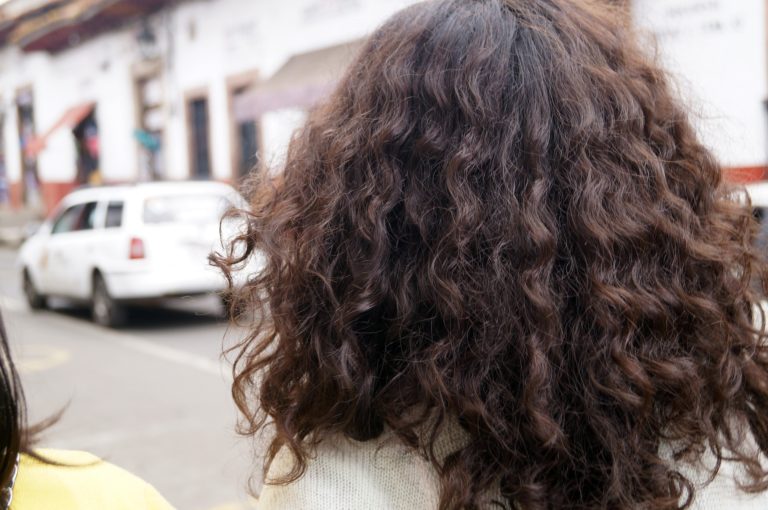Hair Loss and The Curly Girl Method

Today, we’re going to talk about hair loss and the Curly Girl Method.
This post was one I’ve been planning to get to for a while. When the DevaCurl situation came out a few weeks ago, it seemed like it was time to make it a priority. (If you missed the DevaCurl controversy, here’s a BuzzFeed post that explains things.)
If you’ve been following this blog for a while, you know I’ve never used or recommended DevaCurl products.
This was largely because I started the Curly Girl Method to get away from an expensive hair product I was using. Using DevaCurl would have meant trading one high price tag for another, which I wasn’t interested in doing.
Since I have no direct experience with DevaCurl, this post isn’t going to dive into the specifics of that situation. Instead, we’re going to look at the bigger picture of hair loss and the Curly Girl Method.
Specifically, we’ll get into what’s “normal,” what’s not, and what to do if you have concerns.
Side note: I am not a doctor or medical professional. If you’re having serious concerns, you should check in with yours.
Why some “hair loss” with the Curly Girl Method is normal
It’s typically normal to notice more hair in the drain of your shower once you start the Curly Girl Method.
However, it’s very unlikely that you’re actually experiencing more hair loss with the Curly Girl Method than you were before you started (which is why I have hair loss in quotes in the title this section).
According to Healthline, “the American Academy of Dermatologists [says] it’s normal to lose anywhere from 50 to 100 strands of hair per day. For people with longer hair strands, losing them may be more noticeable.”
One of the benefits of the Curly Girl Method is that it helps your curls clump more effectively, leaving you with stronger, more defined curls.
This also means your hair is more twisted together and intertwined than it previously was.
Therefore, when those 50-100 strands detach from your scalp, they don’t fall to the ground quite like they used to. They stay twisted up in your hair until you wash and detangle.
What does “normal” look like?
Generally speaking, you’re likely losing the same number of hair strands each day that you’ve been losing your whole life.
The only difference now is that they’re all coming out of your hair at once when you’re in the shower, as opposed to gradually over the course of your day, which may make it seem more extreme than before.
You’ll likely find an increase in strands wrapped around your fingers when you detangle. Your shower drain may also be noticeably more clogged than it was before.
If you only wash a few days a week, you’ll likely notice even more hair in the drain than when you washed every day. This isn’t necessarily a reason to panic either.
If you’re only washing twice a week, that means there are several DAYS worth of fallen strands trapped in your hair that all come out at once.
I’ve definitely noticed that the more days I go without washing, the more hair is in the drain when I do.
I only have experience with my own hair type, but I would also imagine that the more curly/coiled your hair is, the tighter it will hold on to fallen hair and the more you’ll have in the drain. And I’d also think the looser and wavier your hair is, the less you’ll find in the shower.
Despite the detached hairs you have after washing, you shouldn’t notice any major changes in your hair’s thickness. It should be just as thick and full as it was before–if not more so since you’re taking better care of your hair and scalp.
This will likely result in less breakage and more growth.

When hair loss with the Curly Girl Method isn’t normal
If you notice your hair is getting significantly thinner over time, that’s not often considered a normal side effect of following the Curly Girl Method.
Additionally, I wouldn’t consider it to be normal if you notice that your hair is coming out in clumps. When I detangle my hair, I end up with individual strands wrapped around my fingers. There’s a lot of them! But I never lose entire sections of hair. It’s always strands.
I also wouldn’t consider it normal if you hit the point where the hair you’re pulling out of the drain is larger than the size of your palm (like one person in the BuzzFeed article).
Personally, I usually end up with about a golf ball-sized amount of fallen hair in the drain when I was twice a week.
What’s “normal” will likely vary, but if it seems palm-size excessive, that might be a red flag for you. It would be for me.
If you notice your scalp is significantly itchy, or if there’s burning or irritation, that’s not normal. As a rule of thumb, when it comes to the scalp, I would say if it doesn’t feel good, it probably isn’t.
This isn’t to say some scalp issues aren’t common on the Curly Girl Method. I’ve had some of my own, which you can read about here.
However, there’s a big difference between an annoyance (which is what I could classify my scalp issue) and significant discomfort.
What to do if you have concerns
First, if you’ve noticed hair loss that seems extreme to you, scalp irritation, and/or your hair doesn’t seem to be as healthy as it was before, check up on your products. This applies even if you haven’t changed your products recently.
Sometimes when hair product companies are sold, the new owner tweaks the formula.
I think as curly girls, it can be easy to become loyal to certain brands and products because our hair has been so hard to control for most of our lives. When we find something that works, we’re excited and grateful.
But there are a lot of curly girl approved options these days. If something isn’t working for you like it used to, ditch it.
If your only issue is that it’s not as effective as it used to be, that doesn’t necessarily mean the product is “bad.”
It may just mean that your hair has gotten healthier and/or evolved and has different needs now.
Listen to your hair and be open and willing to make changes when you need to.
Personally, I’ll stick with a product as long as it works for me, but if my hair stops responding how I want it to, I try something new.
Second, you should absolutely talk to a doctor and/or dermatologist, especially for significant hair loss and scalp irritation. In some cases, it may point to a deeper medical concern that isn’t related to hair or hair products.
In other cases, you may need something more medicated or more individualized guidance to correctly diagnose the source of your issue and treat it properly.

Looking for more guidance on your curly hair journey?
For beginners
If you’re new to curly hair care and looking for some help, you should check out the No-Stress Guide to Curly Hair Care!
After spending two years learning and caring for my curly hair, I wanted to create my own, in-depth guide to help fellow curlies create incredible curls in the easiest way possible.
It took me a while, but I eventually found an approach that helped me create a curly hair routine that fits into my life in the simplest way possible. And now I want to help you do the same!

For more intermediate/advanced guidance
If you’ve been on your curly hair journey for a while but still have some struggles, check out Curly Hair Problems!
After spending hours scouring the internet looking for solutions to my own curly hair problems, I found myself wishing for an easier, more comprehensive guide to the most common problems.
So that’s what I created!
Curly Hair Problems offers you 78 total solutions to the five most common curly hair care problems, including frizz, curl clumps, limp curls, product issues, and scalp issues.

Sound off: What’s been your experience with hair loss and the Curly Girl Method? Tell us about it in the comments, and make sure to tell us about your hair type.







Hello! I have been reading you blog to help facilitate starting a modified curly girl. Modified meaning I’m not using much product but I am switching to using solely conditioner and co wash, with a shampoo wash if my hair is feeling off. But recently I found my hair feels really weighted down. It’s smooth and healthy but there seems to be less of it. I had hair with a lot of volume and thickness and now my hair is thick but the volume is gone and it feels weighted down. So you have any tips of things to try to help it feel less weighted? And get some of that natural thickness and volume back?
*do you have any tips. Sorry autocorrect switched it to so
Hey! There are a few possibilities. First, it’s possible that either your conditioner or any product you’re using (I know you said you’re not using much, but I’m taking that to mean you’re using some) could be too heavy for your hair and that’s weighing it down. If that’s the case, you may want to try a different conditioner or product.
Alternatively, if you’re newer to the curly girl method and you’re leaving conditioner and/or water in your hair because your hair needs it, the amount of moisture could be the cause of the extra weight. As you get deeper into the curly girl method and your hair gets more hydrated, you should need less moisture, which will help. If the problem is primarily at your roots, I have a post on how to get more root volume in your hair which may also be helpful.
I hope this is some help!
Thank you!!
Hello Meghan, I am getting worried with more than a hundred strands every time I shampoo, my hair is getting thin and it’s scary! Since the Covid19, I stopped using my method except for shampoo to let my hair breath for awhile and it’s regenerating back. Although I would like to use milder products for my method later, any suggestions?
Unfortunately, everything I know about hair loss and the curly girl method is in this post. I have no direct experience with this and I’m not a doctor or hair professional so I’m really not in the best position to make these kinds of suggestions. If you have a serious concern, it might be best to reach out to a professional of some kind. I wish you luck.
Hey! I have shoulder lenth 3a 2c fine low porosity hair. I counted that 56 hair fall every alternate day. Is it normal?
I’m not a doctor or hair expert, so I can’t say for sure but based on the quote from the Healthline article cited in this post, it sounds like you’re right in the normal range. 🙂
hi! I have a medium length hair and my hair type is a mixture of 2a 2b 2c and some 3a , I’ve been trying to enhance my waves a lot move these past few months , the last 1-3 months I’ve tried the cantu shampoo and conditioner and I’ve noticed a lot more hair loss then usual when I’m detangling, I shower every 3-4 days but I’ll brush my hair every 2 days since it’s so tangled, I really don’t understand why I’m loosing so much hair and I’m getting worried . Any recommendations to help? , thank you
Hey! Unfortunately, everything I know about hair loss is in this post. If you’ve noticed this happening since you started this particular shampoo and conditioner, you can try switching to something else, but if you’re really worried, my best advice would be to talk to a hair or medical professional. Good luck!
I’m a 2c hair type, high porosity…Been doing CGM for 7 months now and still trying to figure out the right method for me and make adjustments. When I first started I lost a lot of hair but it wasn’t any more crazy than you mentioned I guess in your article but it was still alarming! However, I can go almost a week without washing so it’s prolly just about right. Wonderful thing tho, is that my hair stopped falling out drastically about 6 months in…actually have had a ton of growth!! You can’t see my part this was wider than I wanted and I had some very deep receding hair lines on both sides!! This benefit is so worth it all on its own! I like diffusing my hair for more body but stopped to see if I would like it better and have less frizz and it worked! Not as much body but that’s ok…seems like my hair is too big anyway! LOL…AFTER SHAMPOOING I LIKE THE TRICK YOU HAD TO PULL THE HAIR ON THE CROWN UP WITH A LARGE CLIP TO GAIN HEIGHT ON TOP…WORKS GREAT…just letting it dry entirely is hard…I’m impatient. I think I’ve got all the right products now but I’m testing out a acv/peppermint oil/tea tree oil shampoo to try and get rid of a very itchy but NOT scaly scalp…your advice and blogs have helped tremendously! Thank you!
Thank you so much for this! I’m so glad to know the blog has helped and that you’re having so much success. Thanks so much for reading!! <3